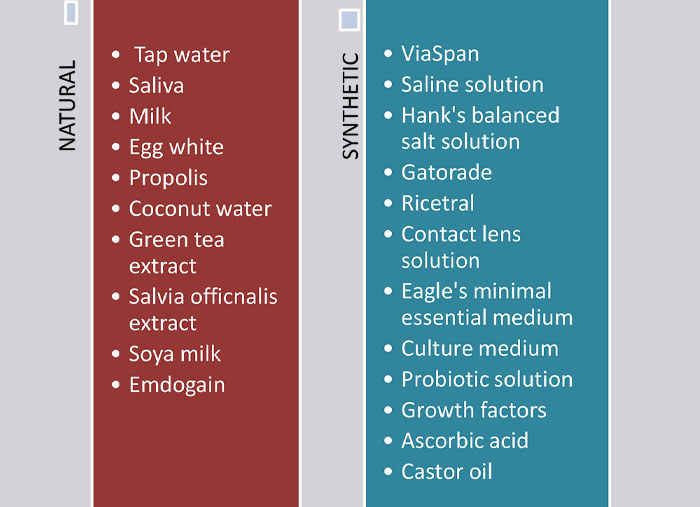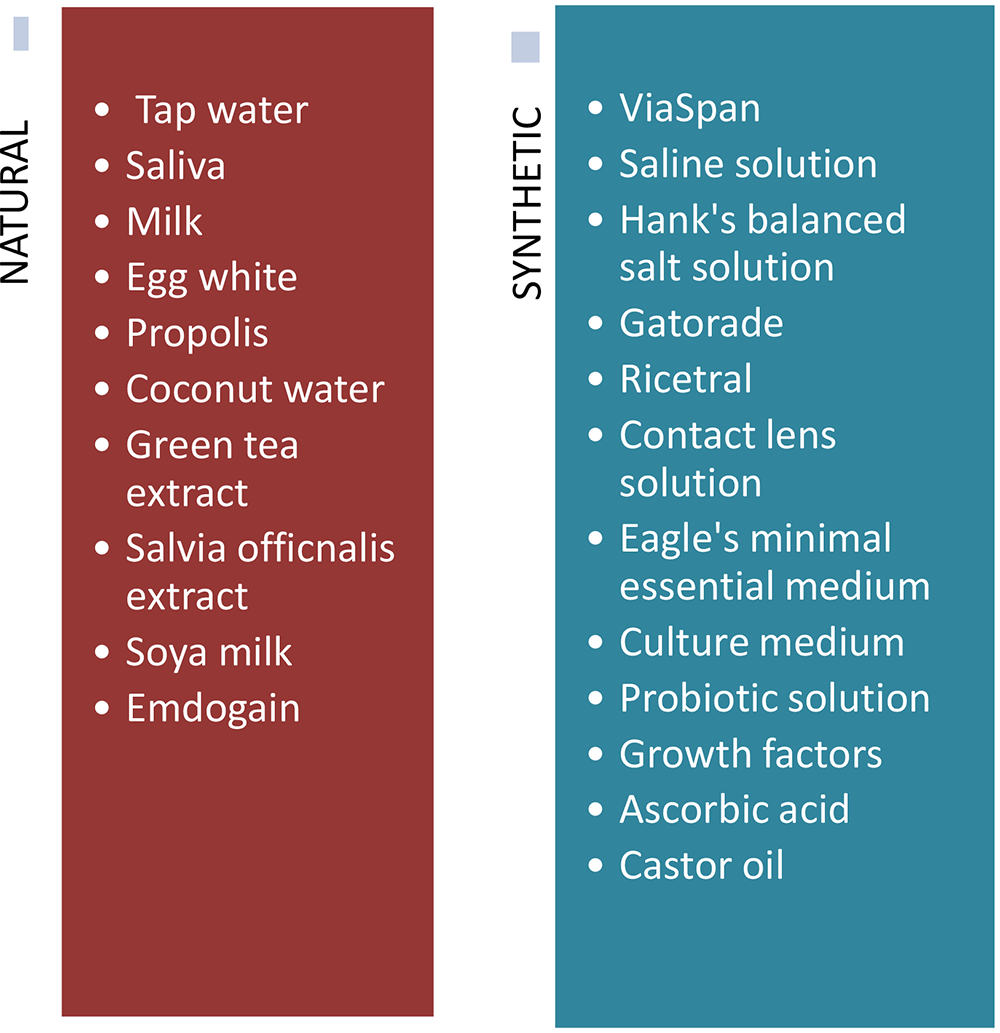- NEED HELP? CALL US NOW
- +919995411505
- [email protected]
Storage Medium for Avulsed Tooth

Avulsion is one of the most severe types of traumatic injuries seen during childhood and adolescence.
Tooth avulsion is a complex traumatic injury characterized by the complete dislodgement of the tooth from its socket, which causes severe damage to the supporting tissues, vascular and nerve structures, which requires a prompt and correct emergency management for the good prognosis.
Ideally, the exarticulated tooth should immediately be replanted after avulsion to prevent dessication of PDL fibers.
However, it is difficult most of the times. A storage media to prevent further damage and to retain the properties of the remaining structures appears to be inevitable during this period
Ideal Requirements of Transport Media
- No antigen antibody reaction
- Less risk of root resorption
- Effective under various conditions
- Antimicrobial
- Sterile
- Long Shelf life and easy availability
- Inexpensive
- Easily available and economical.
- The cellularity of the remaining PDL should be preserved so that new cells can be generated.
- Adherence of osteoclasts to the PDL fibers should be minimized.
- Antioxidant property to protect the damage of the cells from oxidative radicals.
- For optimal cell growth, osmolarity should be similar to body fluids (290- 300 mosmol/ kg) and pH (7.2-7.4).
- Chilled storage media below 370C has been shown to improve extraalveolar storage.
- Different climates and conditions should not reduce its efficiency.
- Capable of removing toxic products.
- Helps in restoring depleted PDL cells.
Classification

NATURAL STORAGE SOLUTION
Tap water:
- Use of tap water to store avulsed teeth is not recommended as it is not compatible with PDL cells because of its hypotonic osmolarity which causes cell lysis, and is reported to causes replacement resorption in avulsed teeth when they are place in it.
- It is considered the least desirable storage medium.
Saliva:
- Saliva is a readily available, natural storage medium.
- Despite this fact, due to the presence of substances like enzymes and bacteria and its non-physiologic osmolarity, which can exert harmful effects on the PDL cells, this can at best be used as an interim storage medium (no longer than 30 minutes). If stored for more than 60 minutes, a significant decrease in functional capacity of PDL cells occurs.
Coconut Water:
- Coconut water is a biological liquid which is pure, sterile and rich in nutrients like amino acids, proteins, vitamins and minerals.
- Readily available in tropical countries, it is an isotonic solution which can be obtained fresh directly from coconuts or commercially in packages and bottles.
- When compared with other media like HBSS, propolis and milk, it was found that coconut water was the most effective in maintaining viability of PDL cells.
- Since the pH of coconut water is 4.1, it has harmful effects on cell metabolism until sufficiently neutralized
Propolis
- Antiinflammatory, antibacterial and antioxidant properties
- Excellent efficiency
Green tea
- Antiinflammatory, antibacterial and antioxidant properties
- Excellent efficiency
- Poor accessibility
Milk
- Milk is one of the sort after traditional storage media as it is cost effective.
- With a ph of 6.5-7.2 and the presence of essential nutrients important for maintaining the viability of PDL cells
- Milk can be considered as acceptable storage medium in most situations, increasing the life of the PDL cells on the root surface,
- Pasteruisation decreases the number of bacteria and its products
- Sour milk should not be used as it is harmful
- Refrigerated milk helps in maintaining the viability of PDL cells
Soy Milk
- Soy milk, the water extract of soybean, contains no cholesterol or lactose and very small amounts of saturated fatty acid .
- It is considered an excellent culture medium forcell growth and biochemical activities
Egg white
- Presence of high protein content, vitamins and being uncontaminated by microbes makes it a good choice.
- With a pH of 6.6 and osmolality 251-258 it has a better incidence of repair than milk for up to 6-10 hours
Salvia officnalis extract
- Salvia Officinalis is a plant from the family Lamiaceae.
- It has been used since ancient times as an astringent and antiseptic.
- The antioxidants present in the extract help to prevent root resorption by inhibiting the effect of osteoclastic cells. Studies have shown that
- Anti-oxidants effects caused due to the presence of its phenolic components like rosmarinic acid, camosic acid, salvianolic acid and derivatives
Emdogain
- Emdogain or emd is a commercialized product which contains from enamel matrix protein.
- No firm conclusion regarding the efficacy of EMD application on healing of replanted and autotransplanted permanent teeth
SYNTHETIC STORAGE SOLUTION
Contact lens solution
- Contact lens solution is a convenient preservation medium for teeth after avulsion injuries as these solutions are available in school or athletic grounds and at home, where most injuries occur.
- They contain buffered, isotonic saline solutions with the addition of preservatives that may preserve the viability of PDL cells.
- Temporary storage media for avulsed teeth, no significant difference in the ability of different contact lens solutions to maintain cell viability has been found.
- The solutions preserve signficantly more viable cells than tap water and Gatorade but are not as effective as HBSS and milk.
Ascorbic acid
- Addition of ascorbic acid to osteoblastic cell lines can stimulate type I collagen production, followed by expression of specific markers associated with osteoblastic phenotypes such as alkaline phosphatises (ALP) and osteocalcin.
Saline solution
- Saline has a pH of 7 and osmolality of 280 msom/kg which are biocompatible to PDL cells.
- The lack of nutrients such as potassium, magnesium etc in saline is a setback as these nutrients are required for the metabolic activity of PDL cells.
- It is acceptable to place avulsed teeth in this storage medium but for not more than 10 minutes
Ricetral
- Ricetral is a commercially available oral rehydration solution consisting of vital salts and glucose required to maintain cell metabolism
ViaSpan
- Cold storage solution which was designed to use in organ transplantation.
- It has a ph of 7.4, osmolality of 320 msom/kg and is a potent
- The major drawback of viaspan is the short expiration, the need to be refrigerated and high cost.
Gatorade
- This drink was originally developed for athletes in order to replenish electrolytes lost during exercise and physical activity.
- Compared to tap water, the use of Gatorade as storage medium yielded better results for PDL cells survival.
- Easily available at sporting events, where avulsion injuries to teeth tend to occur
- Its osmolarity causes cells destruction
- Not recommended for long term storage of avulsed teeth
Hanks’ Balanced Salt Solution (HBSS)
- An isotonic buffer solution containing inorganic salts and a carbohydrate as an energy source.
- It is considered as the best storage medium
- Save-A-Tooth and EMT Tooth saver (Dentosafe)are commercially available tooth storage media
- Hank's Balanced Salt Solution (HBSS) has been recommended as the standard storage medium for an avulsed tooth.
- It is a scientific fluid (not a saltwater mix) that provides all of the nutrients and the correct cell pressure to keep cells alive.
- It is used for various cell culture applications including the short -term maintenance of cells in a non-CO2 environment,washing cells before dissociation or counting, and transporting cells or tissues.
- Components
i. Calcium Chloride (anhydrous)
ii. Magnesium Sulfate (anhydrous)
iii. Potassium Chloride
iv. Potassium Phosphate Monobasic (anhydrous)
v. Sodium Chloride
vi. Sodium Phosphate Dibasic (anhydrous)
vii. D-Glucose
viii. Phenol Red
Eagle’s medium
- Eagle’s medium contains glutamine, penicillin, streptomycin, nystatin, and calf serum.
- Preservation of PDL fibroblasts of the avulsed tooth for a longer period of time before reimplantation was satisfactory with Eagle’s medium.
- It acts by the proliferation of the PDL cells.
- Eagle’s medium can be stored for almost 48 h.
- Its availability at the trauma site does not seem to be practical, but it can be used for the tooth auto-transplantation procedure.
Related posts
April 10, 2025
April 9, 2025
April 4, 2025




